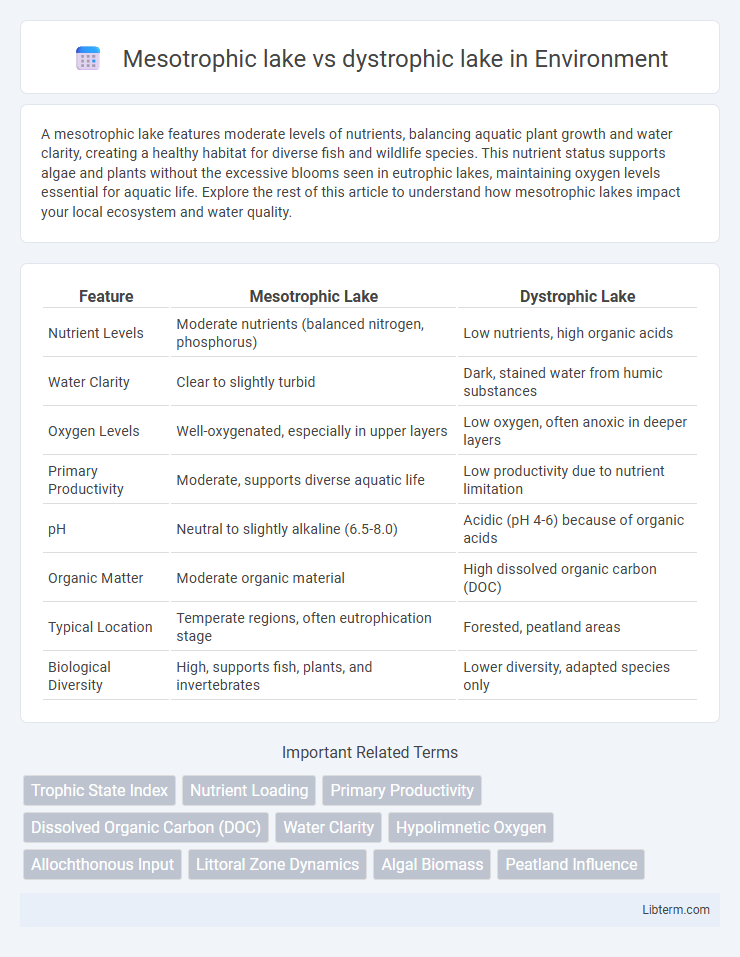A mesotrophic lake features moderate levels of nutrients, balancing aquatic plant growth and water clarity, creating a healthy habitat for diverse fish and wildlife species. This nutrient status supports algae and plants without the excessive blooms seen in eutrophic lakes, maintaining oxygen levels essential for aquatic life. Explore the rest of this article to understand how mesotrophic lakes impact your local ecosystem and water quality.
Table of Comparison
| Feature | Mesotrophic Lake | Dystrophic Lake |
|---|---|---|
| Nutrient Levels | Moderate nutrients (balanced nitrogen, phosphorus) | Low nutrients, high organic acids |
| Water Clarity | Clear to slightly turbid | Dark, stained water from humic substances |
| Oxygen Levels | Well-oxygenated, especially in upper layers | Low oxygen, often anoxic in deeper layers |
| Primary Productivity | Moderate, supports diverse aquatic life | Low productivity due to nutrient limitation |
| pH | Neutral to slightly alkaline (6.5-8.0) | Acidic (pH 4-6) because of organic acids |
| Organic Matter | Moderate organic material | High dissolved organic carbon (DOC) |
| Typical Location | Temperate regions, often eutrophication stage | Forested, peatland areas |
| Biological Diversity | High, supports fish, plants, and invertebrates | Lower diversity, adapted species only |
Introduction to Lake Trophic States
Mesotrophic lakes exhibit moderate nutrient levels that promote balanced aquatic vegetation and diverse fish populations, serving as transitional ecosystems between nutrient-poor oligotrophic and nutrient-rich eutrophic lakes. Dystrophic lakes contain high concentrations of organic matter, often characterized by acidic waters and brownish coloration due to humic substances, which limit primary productivity and reduce biodiversity. Understanding lake trophic states involves assessing nutrient availability, water chemistry, and biological activity to evaluate ecosystem health and guide conservation efforts.
Defining Mesotrophic Lakes
Mesotrophic lakes exhibit moderate nutrient levels, offering balanced biological productivity between oligotrophic and eutrophic conditions. These lakes typically maintain clear waters with noticeable aquatic vegetation and diverse fish populations, reflecting an intermediate state in nutrient enrichment and oxygen availability. In contrast, dystrophic lakes are characterized by high concentrations of organic acids, low nutrient content, acidic pH, and often exhibit stained, brownish water due to humic substances.
Defining Dystrophic Lakes
Dystrophic lakes are characterized by high levels of organic matter, resulting in acidic, nutrient-poor waters with a distinct brownish color caused by humic substances. Unlike mesotrophic lakes, which possess moderate nutrient concentrations and balanced biological productivity, dystrophic lakes have limited primary production due to low phosphorus availability and light penetration. These lakes often support specialized aquatic communities adapted to low nutrient and acidic conditions, contrasting with the more diverse ecosystems found in mesotrophic environments.
Key Physical Differences
Mesotrophic lakes exhibit moderate nutrient levels with clear water and balanced aquatic plant growth, supporting diverse fish populations, while dystrophic lakes contain high concentrations of organic acids and humic substances, resulting in dark, tea-colored water with low nutrient availability. Mesotrophic lakes typically have higher oxygen levels throughout the water column, whereas dystrophic lakes often experience oxygen depletion due to the decay of organic matter. The physical clarity and color difference between these lakes are crucial indicators of their nutrient status and ecological productivity.
Nutrient Levels and Water Quality
Mesotrophic lakes exhibit moderate nutrient levels, primarily nitrogen and phosphorus, which support balanced aquatic ecosystems with clear water and healthy biodiversity. In contrast, dystrophic lakes have low nutrient concentrations and high levels of organic acids and humic substances, resulting in acidic, dark-colored water with reduced biological productivity. Water quality in mesotrophic lakes tends to be higher with better oxygenation, while dystrophic lakes often experience lower oxygen levels and impaired water clarity due to high organic matter content.
Biological Diversity and Productivity
Mesotrophic lakes exhibit moderate biological diversity and productivity, supporting a balanced ecosystem with sufficient nutrients to sustain diverse aquatic plants, fish, and invertebrates. Dystrophic lakes, characterized by high organic matter and low nutrient availability, have lower productivity and reduced biodiversity due to acidic conditions and limited light penetration. The contrasting nutrient levels directly influence the trophic structures, with mesotrophic systems favoring more complex food webs than dystrophic ones.
Color and Transparency Comparison
Mesotrophic lakes typically exhibit moderate water clarity with greenish to bluish hues due to balanced nutrient levels supporting diverse aquatic life. Dystrophic lakes often display brownish or tea-colored water caused by high concentrations of humic substances and dissolved organic matter, resulting in low transparency. The reduced light penetration in dystrophic lakes limits photosynthesis, contrasting with the clearer conditions found in mesotrophic lakes.
Common Flora and Fauna
Mesotrophic lakes typically support diverse aquatic plants such as submerged macrophytes, pondweeds (Potamogeton spp.), and moderate algal populations, alongside fish species like bass, pike, and perch, as well as invertebrates including dragonfly nymphs and freshwater mussels. Dystrophic lakes, often acidic and nutrient-poor, are characterized by low aquatic plant diversity dominated by sphagnum mosses, acid-tolerant species such as Calluna vulgaris, and limited fauna like specialized insects, certain amphibians, and fish species adapted to humic-stained waters, such as brook trout. The contrasting nutrient and pH conditions distinctly influence the biodiversity and ecosystem structure in these lake types.
Environmental Impacts and Threats
Mesotrophic lakes, characterized by moderate nutrient levels and balanced aquatic ecosystems, support diverse species but face threats from nutrient pollution causing eutrophication and algal blooms, which degrade water quality and biodiversity. Dystrophic lakes contain high organic matter and acidic conditions, limiting biodiversity and making them sensitive to acid rain, metal contamination, and climate change effects that alter carbon cycling and water chemistry. Both lake types require targeted conservation efforts to mitigate anthropogenic impacts and preserve ecological integrity.
Conclusion: Choosing the Right Lake for Study
Selecting the appropriate lake type for research depends on the study's ecological focus and water quality parameters. Mesotrophic lakes, with moderate nutrient levels and balanced biological productivity, offer ideal conditions for studying ecosystem dynamics and nutrient cycling. In contrast, dystrophic lakes, characterized by high organic matter and acidic waters, provide unique insights into carbon cycling and adaptations to low nutrient availability.
Mesotrophic lake Infographic

 libterm.com
libterm.com